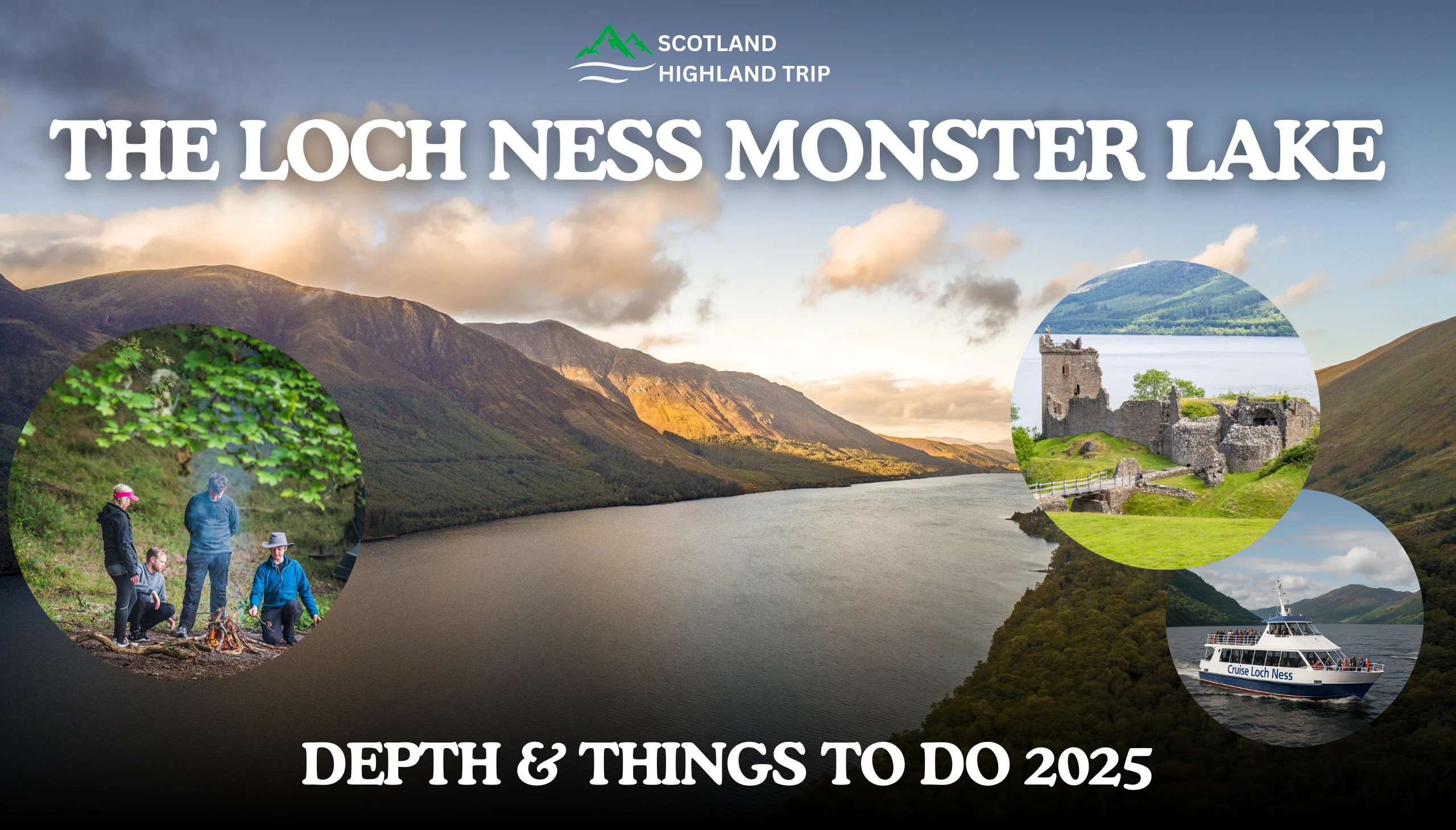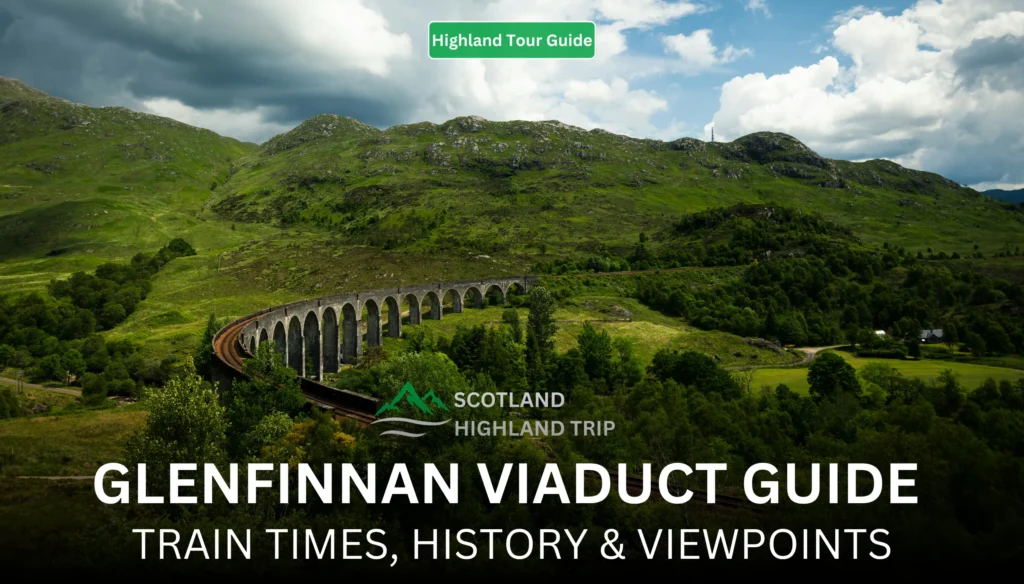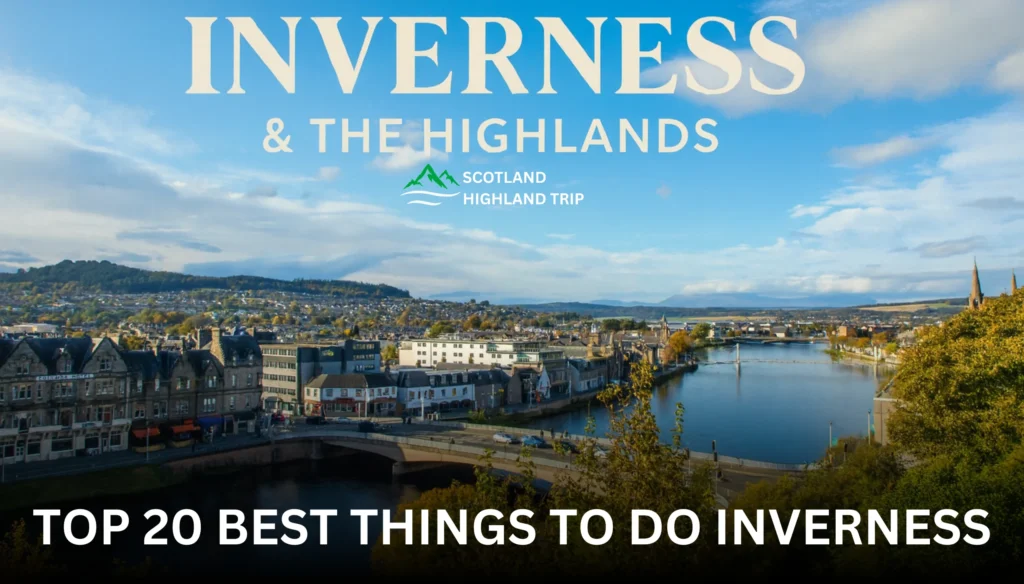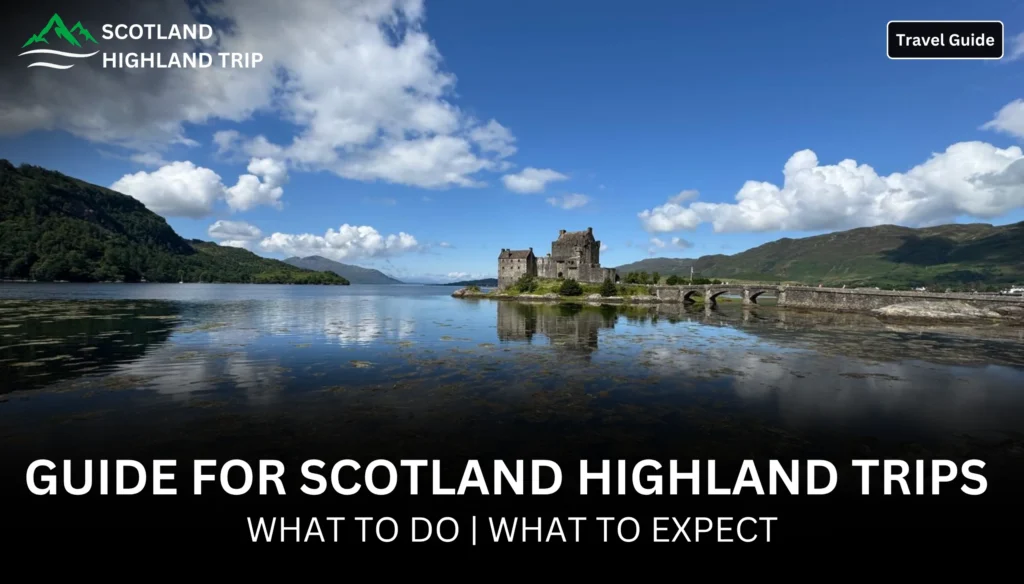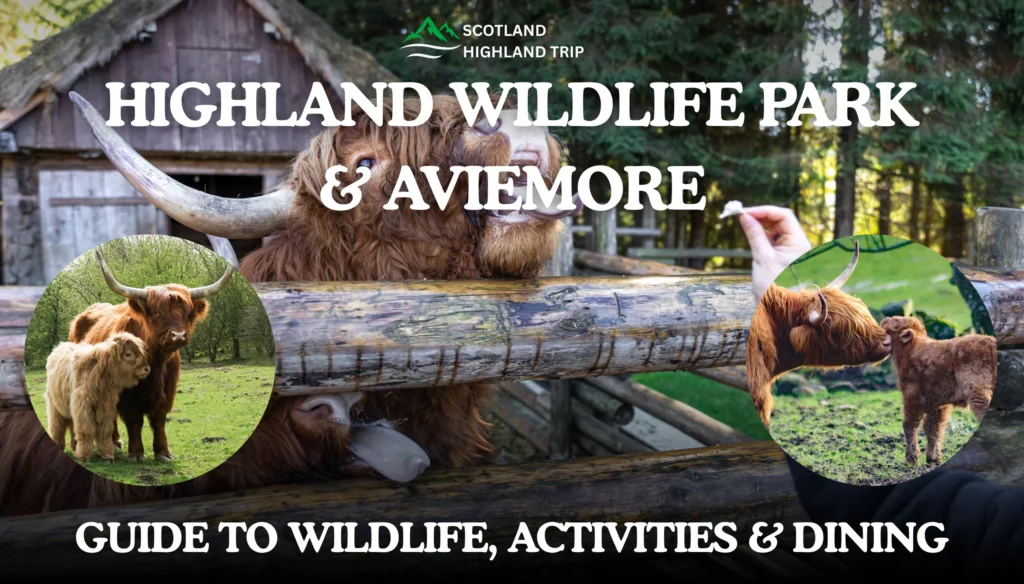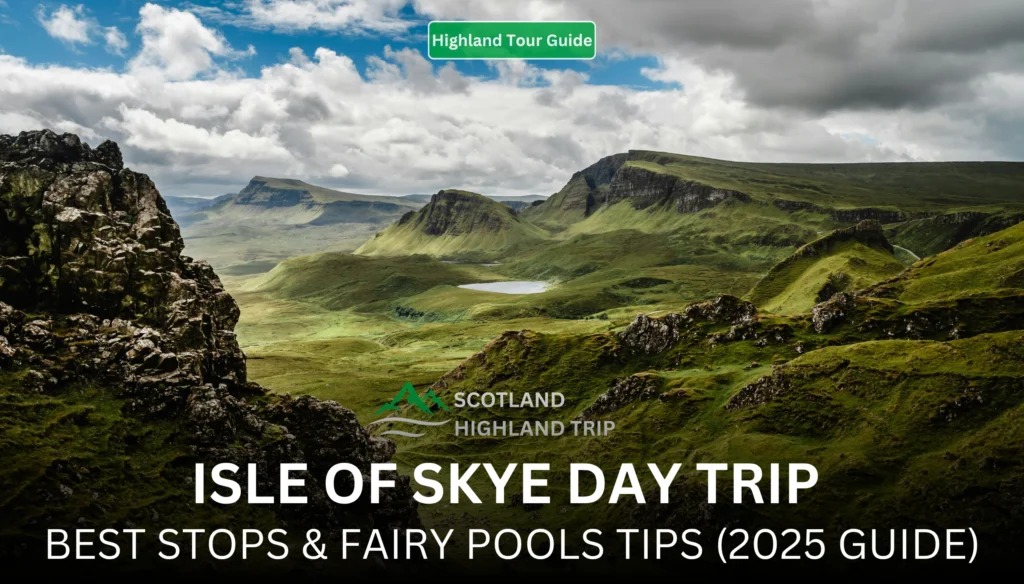Loch Ness conjures up images of mysterious ripples on dark water, fog rolling over green hills and a legendary creature hiding just below the surface. This world‑famous Scottish loch is more than a home for myth; it is a spectacular freshwater lake that contains more water than all of England and Wales’s lakes combined.
With a rich history, breathtaking scenery and a host of activities on its shores, Loch Ness monster lake deserves more than a passing mention on your Highlands itinerary. Whether you’re fascinated by Nessie or simply want to explore a unique corner of the Scottish Highlands, this definitive guide covers everything you need to know from geography and folklore to the best things to do and see in 2025.
Jump to Section
What and Where is Loch Ness Monster Lake?
Loch Ness is a long, slender freshwater lake situated about 10 km (6 miles) south‑west of Inverness in the Scottish Highlands. It stretches roughly 37 kilometres (23 miles) from southwest to northeast and is one of the largest bodies of fresh water in Britain. Although Loch Lomond has a slightly larger surface area, Loch Ness holds the greatest volume of any British lake because of its astounding depth, its deepest point drops to about 230 metres (755 feet).
The loch follows the Great Glen fault line and forms part of the Caledonian Canal, a 60‑mile (100 km) waterway linking the east and west coasts. A road (the A82) hugs much of its western shore, passing through villages such as Drumnadrochit and Invermoriston.
Surprisingly, the surface of Loch Ness sits 16 metres (52 feet) above sea level. The loch’s dark, peaty water and low visibility add to its air of mystery. Peat washed from surrounding hills gives the water a dark tint, making it difficult to see anything below the surface. This murkiness has fuelled speculation about what could lurk in its depths for centuries.
The Legend of Nessie: History & Famous Sightings
Saint Columba’s Encounter (565 AD)
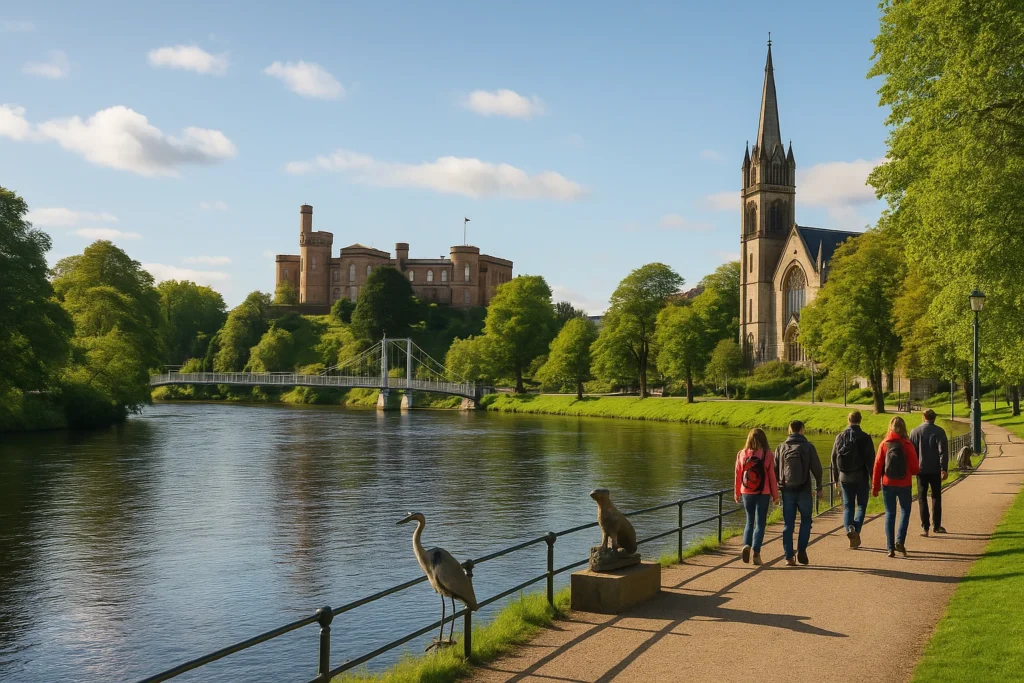
The earliest recorded account of a mysterious creature near Loch Ness dates back to the 6th century. According to Adomnán’s Life of St Columba, the Irish missionary encountered locals burying a man who had been pulled under by a “water beast” in the River Ness. Columba sent one of his followers to swim across; when the beast approached, Columba made the sign of the cross and commanded it to leave. The animal retreated, and the man emerged unharmed. Though this story took place in the river rather than the loch, it is often cited as the first reference to a monster in the area.
20th Century Sightings & the Surge in Popularity
Reports of a large creature resurfaced in the 1930s. In 1933, a local woman named Aldie Mackay claimed to have seen an enormous animal rolling and plunging in the loch while driving along the A82. Her account, published in the Inverness Courier, introduced the term “monster” into popular usage. Later that year, George Spicer and his wife reported seeing a creature with a large body and long neck crossing the road into the water. Their description resembled a prehistoric plesiosaur, capturing the public’s imagination and turning Nessie into a global phenomenon.
In 1934, the so‑called “Surgeon’s Photograph” appeared to show a long-necked creature in the loch. The image became one of the most famous pieces of “evidence” for Nessie’s existence. Decades later it was exposed as a hoax, constructed from a toy submarine and modelling clay. Nevertheless, the photo cemented the loch’s association with monsters and continues to lure curious visitors.
Modern Investigations & Scientific Explanations
Since the 1950s there have been dozens of expeditions, sonar sweeps and scientific studies. Operation Deepscan in 1987 used a flotilla of boats equipped with sonar to scan the entire loch. Researchers detected several unexplained readings but no conclusive evidence of a large creature. In 2018, scientists conducted a DNA survey of Loch Ness’s waters. They found genetic traces of numerous fish and eels but none of a large reptile or unknown animal. One leading theory suggests sightings could be of exceptionally large European eels; another posits misidentifications of wakes, floating logs or sturgeons. Despite the lack of proof, many locals and visitors delight in the enduring mystery and consider Nessie part of the loch’s identity.
How Deep is Loch Ness? Know the Depth & Volume
Loch Ness’s dimensions are staggering. It is 23 miles long and only about 1 mile wide on average, yet its depth plunges to 230 metres (755 feet). A 2016 survey briefly suggested a deeper trench but subsequent research dismissed this as a sonar anomaly. Because of this depth, Loch Ness holds more fresh water than all the lakes in England and Wales combined. Its narrow shape and great depth mean that while wind can whip up choppy waves, the temperature remains relatively constant, rarely dipping below 5 °C. The loch’s vast volume also makes it slow to freeze, a rare event even in harsh winters.
Science vs Myth: Could Nessie Be Real?
While believers cherish Nessie legends, scientists generally attribute sightings to natural phenomena. Here are some of the most popular hypotheses:
- Giant eels: DNA surveys detected large numbers of European eel genetic markers in the loch. An exceptionally long eel surfacing for air could easily be mistaken for a serpent‑like creature.
- Sturgeon or catfish: Occasionally, Atlantic sturgeon or Wels catfish stray into Scottish waters. These fish can reach lengths over 2 metres, have ridged backs and move slowly near the surface, creating a Nessie‑like silhouette.
- Floating debris and wakes: Logs, branch mats and waves from passing boats often create V‑shaped wakes. In certain light and weather conditions, these shapes can appear like humps or necks in the water.
- Seiches and seismic gas: The loch may experience standing waves (seiches) or release methane bubbles from decaying vegetation, causing sudden disturbances on the surface.
- Psychological factors: When people expect to see a monster, they interpret ambiguous shapes accordingly. The human brain is wired to recognise patterns, so ripples, birds and otters can easily become monsters in our imagination.
Although no evidence points to a surviving plesiosaur or dinosaur, the legends add a sense of magic and fun to visiting Loch Ness. For many travellers, the possibility of a glimpse is part of the allure. As our tours often remind guests, keeping an open mind and a keen eye enhances the experience, even if the only thing you spot is a beautiful view.
Things to Do at Loch Ness
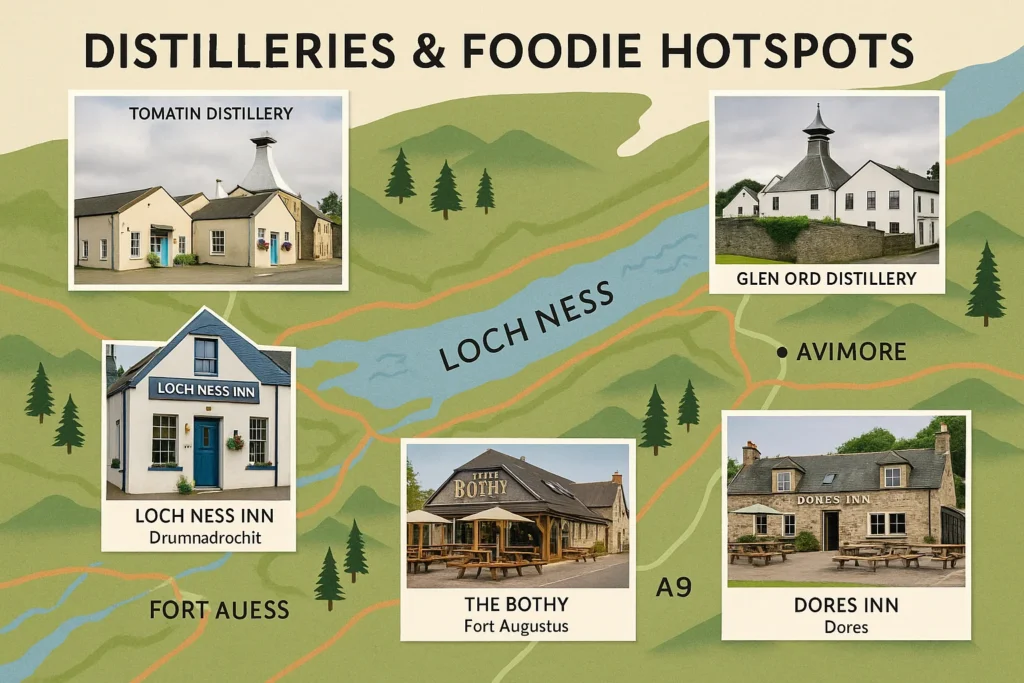
Loch Ness offers far more than monster‑watching. From historic castles to scenic hikes and whisky distilleries, the area rewards those who linger. We recommend allocating at least two days to explore the loch and its surroundings. Here are the highlights:
1. Visit Urquhart Castle & Grant Tower
The ruins of Urquhart Castle stand dramatically on a promontory along the western shore of Loch Ness. For 500 years the castle guarded the Great Glen, changing hands between Scottish clans and suffering many sieges. Today visitors can wander through the gatehouse, climb Grant Tower for sweeping views of the loch, and imagine life during Scotland’s wars of independence. A visitor centre tells the castle’s turbulent story and houses artefacts discovered on site.
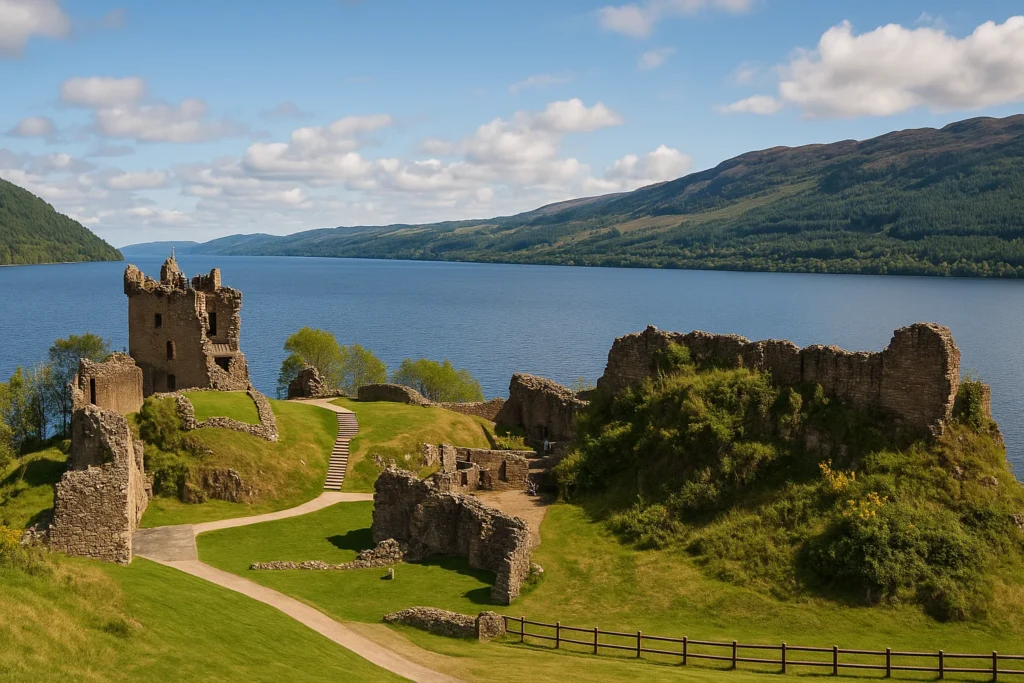
2. Explore the Loch Ness Centre & Exhibition
Located in Drumnadrochit, the Loch Ness Centre and Exhibition combines natural history, folklore and modern science. Interactive exhibits cover geological formation, underwater ecology, and the history of monster sightings. You can watch films about Operation Deepscan and DNA studies, view replicas of famous photographs and evaluate evidence yourself. The centre is perfect for families and anyone curious about the mix of myth and reality.
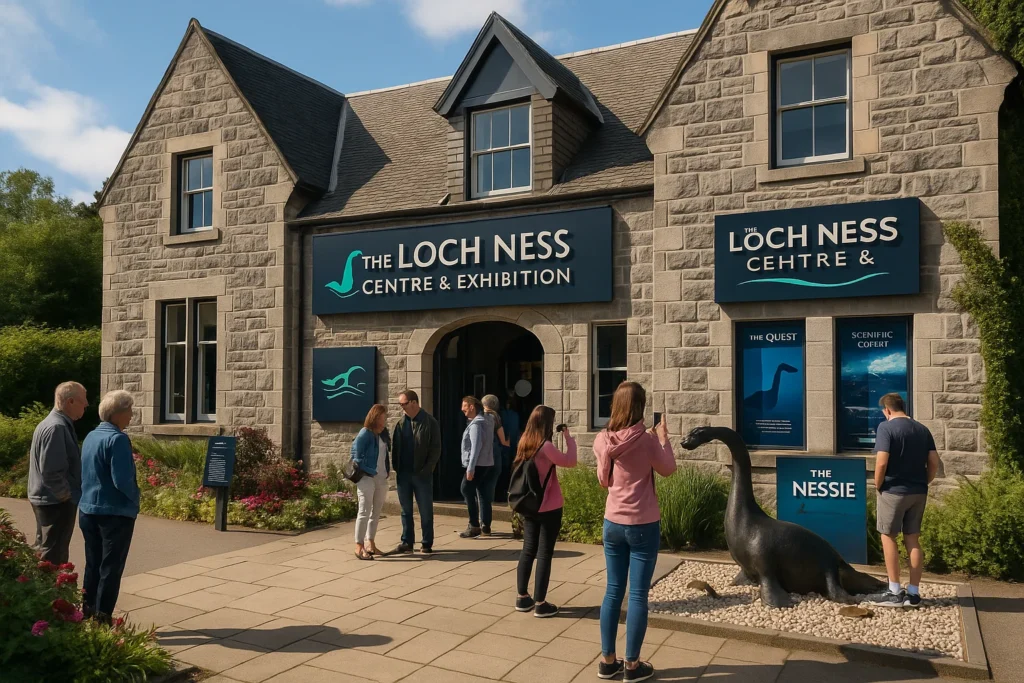
3. Stroll the Loch Ness Trail & Scenic Walks
The Loch Ness 360° Trail is a 80‑mile (129 km) circular route that circumnavigates the loch, linking existing paths such as the Great Glen Way and South Loch Ness Trail. You can hike or cycle segments of the trail for half‑day or full‑day adventures. Popular sections include:
- Invermoriston to Drumnadrochit: A moderate section along forest tracks and open moorland with fantastic loch views.
- Dores to Foyers: This south‑side route passes through woodlands and open hillside, rewarding walkers with vistas over the water and glimpses of wildlife.
- Fort Augustus to South Loch Ness: A quiet stretch exploring lesserknown villages and the historic Wade’s Road.
Shorter walks include the path from Dores village to Torr Point, and the woodland trails near Inverfarigaig. If you prefer a paved route, stroll along the River Ness in Inverness; this gentle walk offers glimpses of local wildlife and art installations.
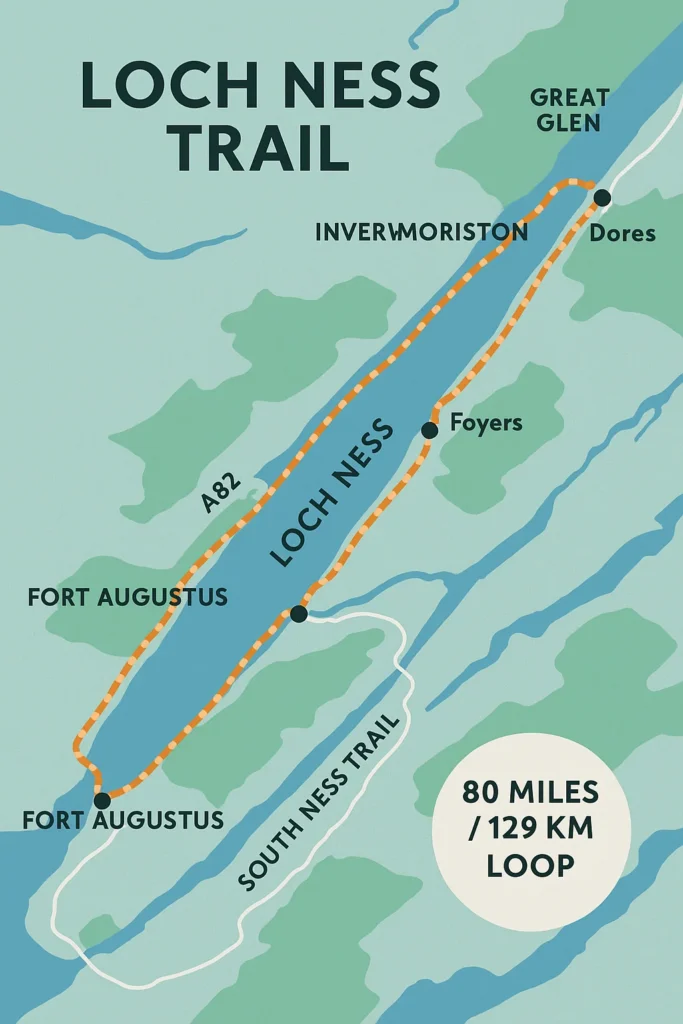
4. Cruise the Loch by Boat
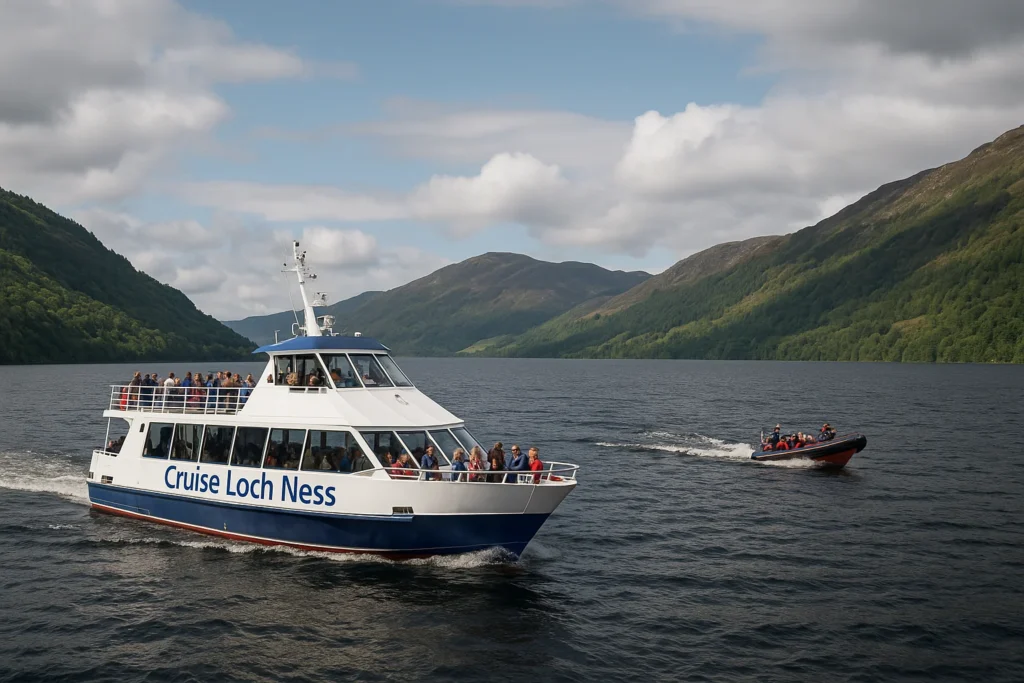
A boat trip is perhaps the most relaxing way to experience Loch Ness. Operators run cruises from Inverness, Dochgarroch, Fort Augustus and Drumnadrochit. Options range from one‑hour sightseeing trips to half‑day excursions that include castle visits. Modern vessels have open decks for unobstructed views as well as heated indoor cabins and sonar displays showing underwater topography. Some operators even host evening cruises with live commentary and whisky tastings.
If you want an adrenaline boost, join a RIB (Rigid Inflatable Boat) tour. These high‑speed boats skim across the water, visiting secluded bays and waterfalls on the south shore.
5. Discover Fort Augustus & the Caledonian Canal
The village of Fort Augustus sits at the southern end of the loch. Once a garrison fort, it now centres on a flight of locks on the Caledonian Canal. Here you can watch boats navigate the lock staircase, learn about the canal’s construction and stroll along the towpath. Quaint cafés and shops line the canal; don’t miss grabbing a homemade pie and watching yachts pass by. Fort Augustus also hosts a small Clansman Centre where costumed guides demonstrate Highland weapons and daily life in the 17th century.
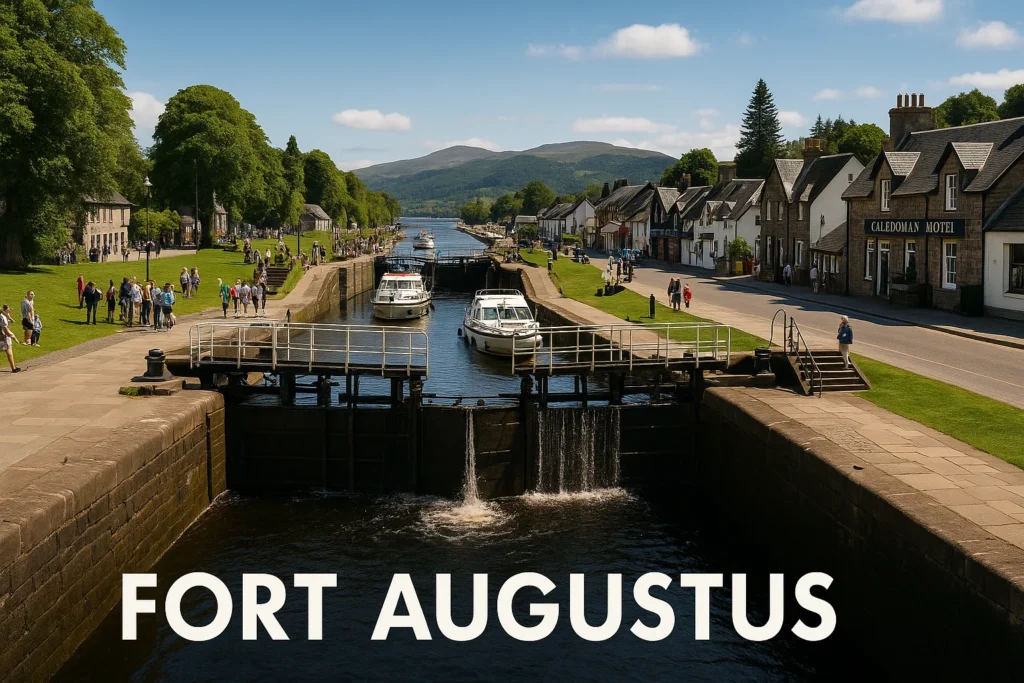
6. Go Monster Spotting at Dores & the Nessie Hunter Caravan
The village of Dores on the north‑eastern shore offers one of the best natural viewpoints over Loch Ness. The pebbled beach looks directly down the length of the loch. Here you’ll find the famous Nessie Hunter Caravan, where local legend Steve Feltham has lived for decades scanning the loch with binoculars and cameras. Chat with Steve about his lifelong search, he enjoys sharing stories and sells Nessie crafts. Dores Inn, a rustic pub nearby, serves hearty meals and local ales.
7. Visit Foyers & the Falls of Foyers
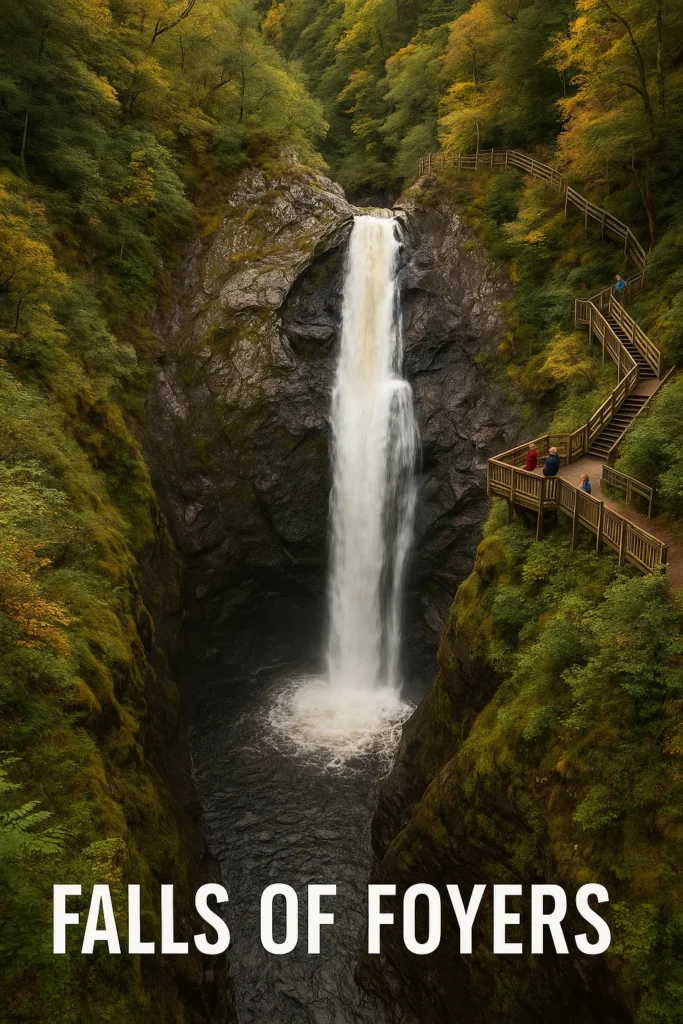
On the quieter south side lies Foyers, home to a spectacular 165‑foot (50 m) waterfall that tumbles into a gorge before flowing into Loch Ness. Poet Robert Burns visited the Falls of Foyers in 1787 and wrote an ode to their beauty. A well‑maintained woodland path leads to viewing platforms overlooking the falls and glimpses of red squirrels. The nearby café offers homemade cakes and views across the loch.
8. Learn at Inverness & the River Ness Walkway
For many visitors, Inverness acts as the gateway to Loch Ness. Scotland’s northernmost city boasts attractions of its own: Inverness Castle, a cathedral, Victorian Market and museums. A lovely walk along the River Ness and the Ness Islands reveals herons, seals and sculptures. From the city you can join day tours to Loch Ness, Glenfinnan Viaduct, Isle of Skye and more.
9. Explore Nearby Distilleries & Foodie Hotspots
No visit to Scotland is complete without tasting whisky. Near Loch Ness you can tour Tomatin Distillery to the east or Glen Ord Distillery on the Black Isle. For beer, head to the Black Isle Brewery. Foodies should try the Loch Ness Inn in Drumnadrochit, The Bothy in Fort Augustus or the lochside café at Dores Inn. Reserve in advance during summer.
10. Experience the Loch Ness Marathon & Outdoor Events
Each September, runners from around the world tackle the Loch Ness Marathon, a scenic race starting near Fort Augustus and finishing in Inverness. The route follows the south shore, offering stunning views and enthusiastic local support. The weekend also hosts shorter runs, family walks and a festival village. Throughout the year, the loch plays host to sailing regattas, music festivals and Highland games. Check the local calendar when planning your trip.
Visiting Loch Ness: Travel Tips & Practical Information
Getting There: Car, Bus & Train
By car: From Inverness, follow the A82 along the western shore. Fort William lies to the south along the same road. Roads are generally good, though single‑track sections appear on the south side. Remember to keep to the left, give way at passing places and watch for deer.
By bus: Frequent buses run from Inverness Bus Station to Drumnadrochit, Urquhart Castle and Fort Augustus, making it easy to explore without a car. Citylink services connect Inverness with Fort William and Glasgow.
By train: Although the railway does not run along Loch Ness itself, trains connect Inverness to Glasgow, Edinburgh and other Scottish cities. From the station you can join tours or hire a car. For a scenic rail excursion, ride the Kyle Line to Kyle of Lochalsh or the Far North Line to Thurso.
Best Time to Visit & Weather
The Scottish Highlands experience cool summers, mild winters and frequent rain. May through September is peak season, offering long daylight and open attractions. July and August can be busy; if you prefer fewer crowds, visit in April, late September or October when autumn colours are spectacular. Winters are quiet but many businesses close. Pack layers, waterproofs and midgie repellent in summer.
Accommodation & Places to Eat
The Loch Ness area boasts a range of accommodation, from luxury hotels to cosy B&Bs and campsites. Popular bases include Drumnadrochit, Fort Augustus and Inverness. Book well in advance during summer or marathon weekends. When it comes to dining, expect hearty Highland fare: venison, seafood, Cullen skink, haggis and fresh baking. For a special treat, dine at Boath House near Auldearn or Chez Roux at Inverness’s Rocpool Reserve.
Loch Ness Monster Photos & Pictures: Fact vs Fiction
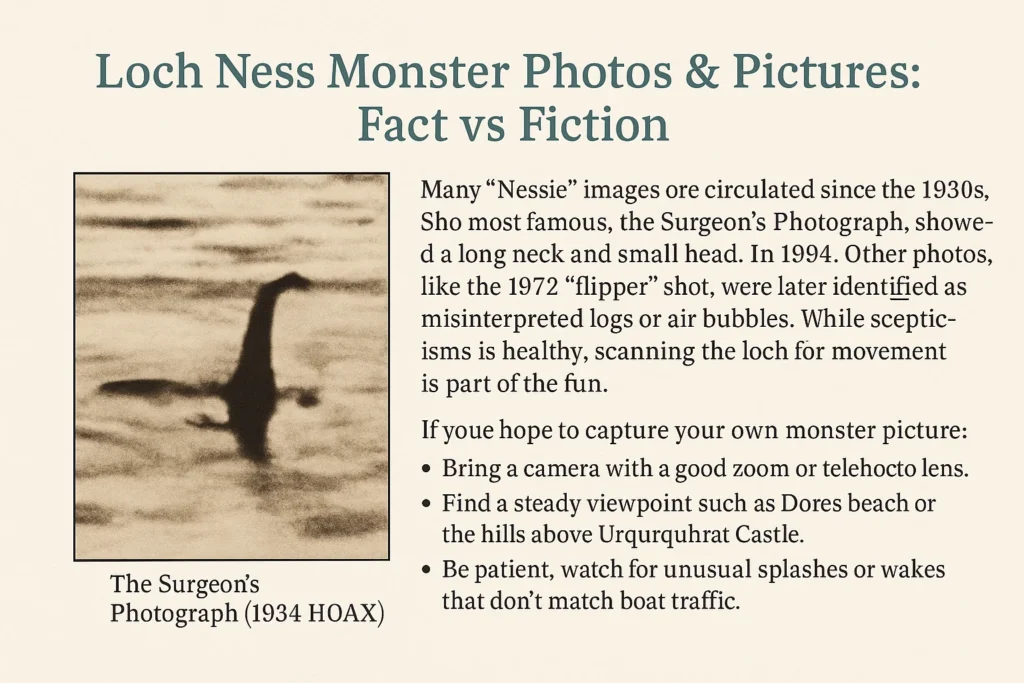
Many “Nessie” images have circulated since the 1930s. The most famous, the Surgeon’s Photograph, showed a long neck and small head. In 1994, one of the men involved confessed that it was a hoax. Other photos, like the 1972 “flipper” shot, were later identified as misinterpreted logs or air bubbles. While scepticism is healthy, scanning the loch for movement is part of the fun. If you hope to capture your own monster picture:
- Bring a camera with a good zoom or telephoto lens.
- Find a steady viewpoint such as Dores beach or the hills above Urquhart Castle.
- Be patient, watch for unusual splashes or wakes that don’t match boat traffic.
- Record a video; movement often reveals whether a shape is a creature or drifting debris.
Fun Facts & Myth‑Busters About Loch Ness
- Largest by volume: Loch Ness holds about 7.4 km³ of water, more than all of England’s and Wales’s lakes combined.
- Small island: Loch Ness has one artificial island called Cherry Island (Eilean Muireach), built during the Iron Age.
- Name origin: The word “Ness” likely comes from an old Celtic term meaning “roaring one”.
- Lighthouse & lifeboat: Lighthouses mark both ends of the loch and an RNLI lifeboat station operates at Drumnadrochit.
- Caledonian Canal: Only one‑third of the Caledonian Canal is man‑made, the rest uses natural lochs including Loch Ness.
- No freezing: Because of its volume and depth, the loch rarely freezes, even when shallow Highland lochs are solid ice.
Frequently Asked Questions
How deep is Loch Ness?
The loch’s deepest point is about 230 metres (755 feet). A later sonar anomaly suggesting 271 metres was found to be an error.
Where is Loch Ness located?
It lies in the Scottish Highlands, about 10 km south‑west of Inverness, with Fort Augustus at the opposite end.
How big is Loch Ness?
Roughly 37 km (23 miles) long, 1 km (1 mile) wide and 56 km² (22 sq mi) in area.
Is there really a monster?
No definitive evidence exists. Sightings may be misidentified animals, waves or hoaxes. However, part of the magic of visiting is embracing the mystery and making up your own mind.
Can I swim in the loch?
Yes, but the water is cold year‑round and visibility is low. Swim in designated areas and never alone; watch for boat traffic.
Are there boat tours?
Yes, several companies offer cruises and RIB trips from Inverness, Dochgarroch, Drumnadrochit and Fort Augustus. Book ahead in summer.
What are the best viewpoints?
Dores Beach, the hills above Urquhart Castle, Invermoriston’s hilltop and the viewpoints on the South Loch Ness Trail offer sweeping vistas.
How do I get from Loch Ness to Glenfinnan Viaduct?
Our day tours take you across the Highlands to see both the viaduct and the loch in one trip. Driving on your own, the journey is roughly two hours via Fort William.
Plan Your Loch Ness Adventure with Us
Ready to experience Loch Ness for yourself? Our Loch Ness & Highlands Tours depart from Inverness, Edinburgh and Glasgow and are designed to maximise your time. Travel in a comfortable mini‑coach with an experienced local guide, stop at Urquhart Castle, cruise the loch and learn the real stories behind Nessie. Combine Loch Ness with Glenfinnan Viaduct, Isle of Skye or the Cairngorms for an unforgettable multi‑day adventure. Contact us today to plan your perfect Highlands itinerary.
Disclaimer: This blog provides official guidance for visitors, with all details carefully researched. Images are included for reference and illustration purposes only.

Emma is a solo traveler and freelance travel writer from New Zealand who spent three weeks exploring the Scottish Highlands. With a deep appreciation for history and landscapes, she booked a series of day tours and a private chauffeur journey with Scotland Highland Trip. From Loch Ness to the Cairngorms, she documented her experience through vivid blog posts and drone footage.

